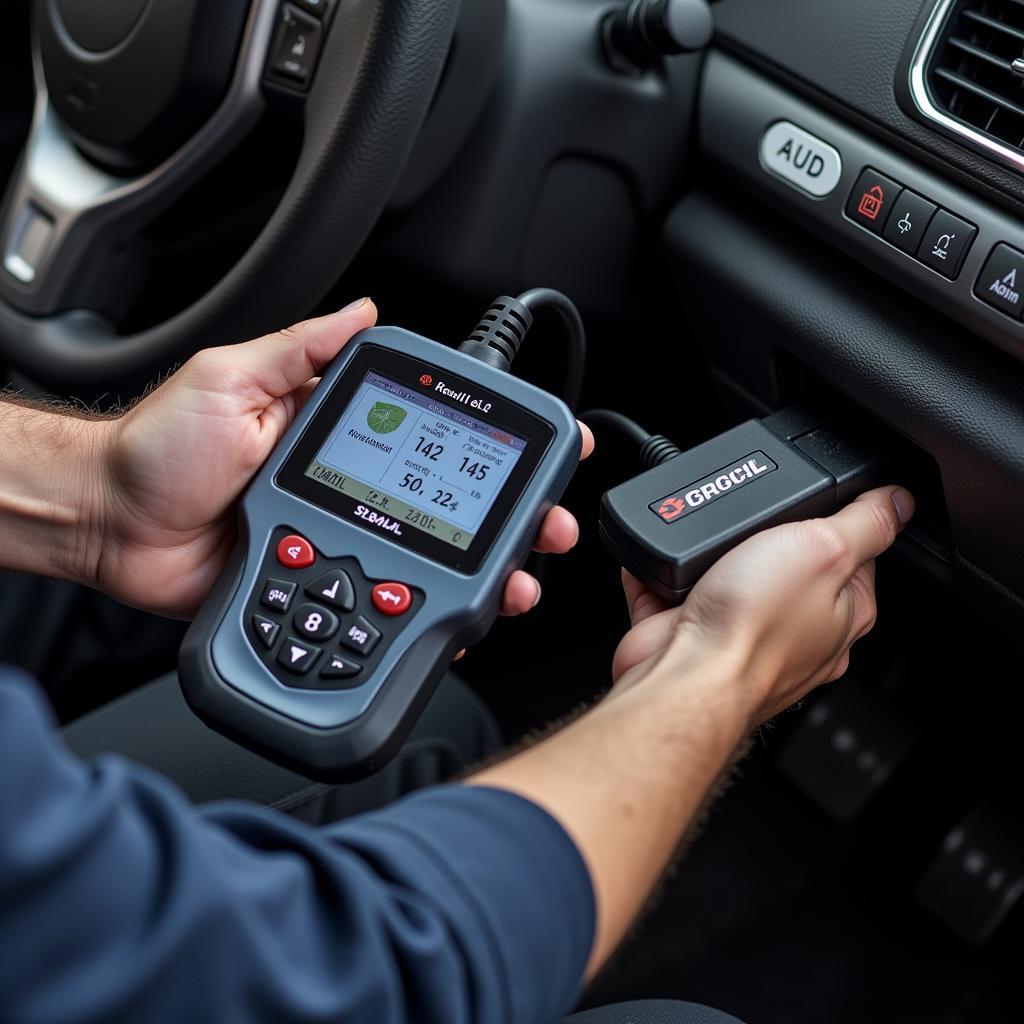The Mvs 2017 Diagnostic Tool is an essential piece of equipment for any mechanic or car enthusiast working on modern vehicles. This sophisticated tool allows users to diagnose and troubleshoot issues with a wide range of vehicle makes and models. Whether you’re dealing with engine problems, transmission faults, or electrical gremlins, the MVS 2017 can provide the insights you need to get the job done right.
What is the MVS 2017 Diagnostic Tool?
The MVS 2017 is a handheld, portable diagnostic scanner that interfaces with a vehicle’s onboard computer system. It retrieves diagnostic trouble codes (DTCs), live data streams, and other crucial information from the vehicle’s electronic control units (ECUs).
[image-1|mvs-2017-diagnostic-tool|MVS 2017 Diagnostic Tool in Use|A mechanic is shown using the MVS 2017 diagnostic tool to diagnose a car problem. The tool is plugged into the car’s OBD-II port and displays information on its screen.]
Why is the MVS 2017 Important?
Modern vehicles are increasingly reliant on sophisticated electronics and computer systems. The MVS 2017 diagnostic tool acts as a window into these systems, providing:
- Accurate Diagnostics: Pinpoint the root cause of issues, reducing guesswork and unnecessary repairs.
- Real-Time Data: Monitor live data streams from sensors, actuators, and other components to analyze performance.
- Advanced Functions: Depending on the software version, the MVS 2017 may offer functions like bi-directional control, allowing users to activate components for testing.
Key Features of the MVS 2017
The MVS 2017 boasts a range of features designed to streamline the diagnostic process:
- Wide Vehicle Coverage: Supports a broad range of vehicle makes and models, often including both domestic and import vehicles.
- User-Friendly Interface: An intuitive interface makes navigating menus and accessing data simple, even for those new to diagnostic tools.
- Regular Software Updates: Manufacturers often provide updates to expand vehicle coverage and add new features.
How to Use the MVS 2017 Diagnostic Tool
Using the MVS 2017 effectively involves a few key steps:
-
Connect the Tool: Locate the vehicle’s OBD-II port (usually under the dashboard on the driver’s side). Connect the MVS 2017 using the provided cable.
-
Turn on the Ignition: Turn the ignition to the “on” position without starting the engine. This powers up the vehicle’s electronics.
-
Access the Main Menu: The MVS 2017 will boot up and display its main menu. Options typically include reading codes, viewing live data, and accessing special functions.
[image-2|mvs-2017-menu-options|MVS 2017 Main Menu Options|A close-up of the MVS 2017 screen displaying the main menu options: Read Codes, Live Data, Special Functions.]
-
Read Diagnostic Trouble Codes: Select “Read Codes” to retrieve any stored DTCs. The tool will display the codes and their definitions, providing clues about the issue.
-
View Live Data: The “Live Data” option allows you to monitor real-time sensor readings. This is invaluable for diagnosing intermittent issues or analyzing system performance.
-
Utilize Special Functions: If equipped, the MVS 2017 may offer special functions like component activation, adaptations, or resets.
Common Uses of the MVS 2017
The MVS 2017 proves invaluable in numerous automotive repair scenarios:
- Engine Diagnostics: Diagnose misfires, poor fuel economy, or check engine lights by analyzing engine data.
- Transmission Problems: Troubleshoot issues with shifting, slipping, or harsh engagement by monitoring transmission sensors.
- ABS and Airbag Systems: Read and clear codes related to Anti-lock Braking Systems (ABS) and Supplemental Restraint Systems (SRS).
Tips for Getting the Most Out of Your MVS 2017
- Keep Software Updated: Regular software updates ensure compatibility with the latest vehicles and often include new features.
- Invest in Training: Consider training courses to deepen your understanding of vehicle electronics and diagnostic procedures.
- Consult Repair Manuals: Use the MVS 2017 alongside reliable repair manuals for your specific vehicle to interpret data accurately.
Conclusion
The MVS 2017 diagnostic tool is an indispensable asset for automotive professionals and DIY enthusiasts. Its ability to provide in-depth insights into a vehicle’s electronic systems makes it crucial for accurate diagnostics and efficient repairs. By understanding its features and proper usage, you can leverage the power of the MVS 2017 to keep vehicles running smoothly.
For expert advice and support regarding automotive diagnostic tools, contact the specialists at ScanToolUS at +1 (641) 206-8880 or visit our office located at 1615 S Laramie Ave, Cicero, IL 60804, USA.

